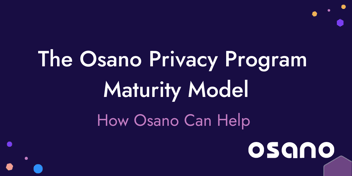
How Osano Can Help
How Osano Can Help You Mature Your Privacy Program Building, running,...
Read NowGet an overview of the simple, all-in-one data privacy platform
Manage consent for data privacy laws in 50+ countries
Streamline and automate the DSAR workflow
Efficiently manage assessment workflows using custom or pre-built templates
Streamline consent, utilize non-cookie data, and enhance customer trust
Automate and visualize data store discovery and classification
Ensure your customers’ data is in good hands
Key Features & Integrations
Discover how Osano supports CPRA compliance
Learn about the CCPA and how Osano can help
Achieve compliance with one of the world’s most comprehensive data privacy laws
Key resources on all things data privacy
Expert insights on all things privacy
Key resources to further your data privacy education
Meet some of the 5,000+ leaders using Osano to transform their privacy programs
A guide to data privacy in the U.S.
What's the latest from Osano?
Data privacy is complex but you're not alone
Join our weekly newsletter with over 35,000 subscribers
Global experts share insights and compelling personal stories about the critical importance of data privacy
Osano CEO, Arlo Gilbert, covers the history of data privacy and how companies can start a privacy program
Upcoming webinars and in-person events designed for privacy professionals
The Osano story
Become an Osanian and help us build the future of privacy!
We’re eager to hear from you
Interested in partnering with us?
Increase Trust. Stay Compliant. Get Cool Swag.
Inquiries and Osano in the news
Add Osano data privacy ratings and recommendations to your application
.webp?width=1220&height=1090&name=Osano-guarantee-seal%20(1).webp)
Benchmark and Grow Your Organization’s Privacy Program
Governance and accountability refers to the policies, procedures, and processes that an organization puts in place to ensure that its data privacy program is effective and compliant with relevant laws and regulations. It also includes the mechanisms for ensuring that individuals and teams within the organization are held accountable for meeting the organization’s privacy obligations. Without such a system in place, proving compliance, ensuring follow-through, and identifying compliance gaps are significantly more challenging.
A privacy program with immature governance and accountability practices has little or no formal structure for overseeing data privacy at the organization, and the individuals who are accountable for data privacy at the organization and team level is unclear or undefined. There Is likely no internal auditing of privacy policy adherence, or if there is, it is done in a retroactive manner. When internal noncompliance is identified, there may be no follow-up or remediation efforts. It may be the case that individuals who ought to be accountable for privacy in their domain are unaware of privacy policies and procedures at all.
In contrast, mature governance and accountability practices include clear policies and procedures for handling personal data, oversight mechanisms to ensure compliance with those policies, and accountability structures to ensure that individuals and teams within the organization are held accountable for meeting their privacy obligations. The organization regularly assesses its privacy program to identify and address any gaps, and it has mechanisms in place to monitor and report on privacy risks and incidents.
Establishing strong governance and accountability practices can seem abstract at first, but privacy professionals can mature these practices through the following actions:
With Osano, building, managing, and scaling your privacy program becomes simple. Schedule a demo or try a free 30-day trial today.